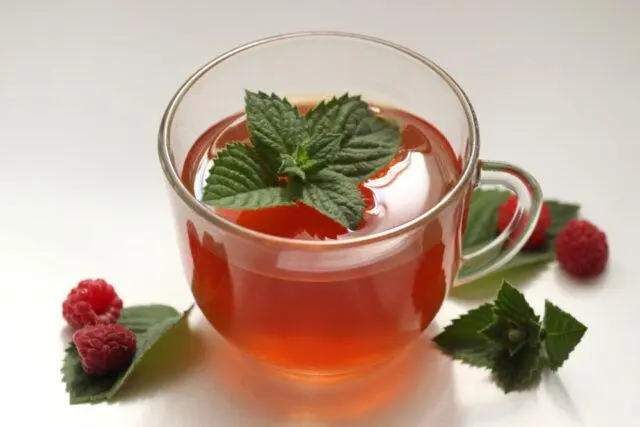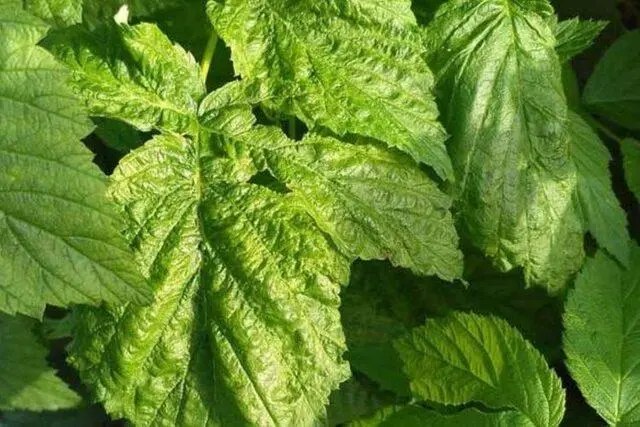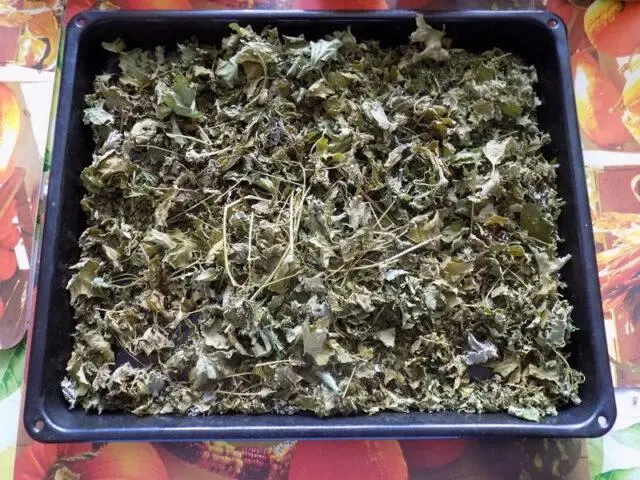Contents
Drying raspberry leaves for tea is necessary according to special rules. Only in this case, the raw materials will retain a full supply of vitamins and trace elements.
Can you use raspberry leaves for tea?
Raspberry leaves are a useful herbal raw material with numerous medicinal properties. On their basis, not only healing decoctions and infusions are prepared, but also fragrant tea. You can use such a drink both for general health promotion and for pleasure.
Raspberry leaf plates contain many vitamins and organic acids, tannins and essential oils. Properly brewed tea based on raw materials:
- improves digestion and relieves inflammation in the stomach and intestines;
- normalizes the work of the cardiovascular system and activates blood circulation;
- reduces cholesterol levels and prevents the development of atherosclerosis;
- has a diaphoretic and antipyretic effect;
- thins mucus and promotes coughing;
- improves memory and increases efficiency;
- accelerates recovery from influenza and SARS;
- stimulates the kidneys and cleanses the liver of toxins.
It is recommended to consume leaf tea no more than twice a day. In excessive amounts, it can provoke the development of side effects.

Raspberry leaf tea normalizes sleep and relieves stress
When to harvest raspberry leaves for the winter
Harvesting raspberry leaves for drying is recommended in early or mid-June. During this period, there is an active formation of stems and young green plates. Vegetable raw materials are of the highest quality and contain a maximum of vitamins and organic acids.
During the flowering period, the foliage also remains useful, but it is no longer recommended to cut it off for drying. This will negatively affect fruiting and reduce the yield of the shrub. You can also collect raspberry leaves in September, but there will be much less useful substances in them. In addition, it will be more difficult to find plates that are not damaged by diseases and pests, suitable for drying, in the fall.
What raspberry leaves to collect
For drying for tea, only healthy and intact raspberry leaves should be used. When harvesting, you need to cut off whole plates with a bright green uniform color, without yellow, brown or black spots. The best and most useful are the leaves located closer to the top of the shrub.
You can not take for drying plates with a dark or light coating on the surface, as well as with large or small holes. Such leaves are highly likely to be damaged by insects or fungus.
Rules for collecting raspberry leaves for tea
To collect foliage for drying, choose raspberries that grow in an ecologically clean place. You can not cut off shrubs located near roads and railways, near industrial facilities and within the city. The leaves of such raspberries accumulate too many toxic substances and heavy metals. There will be almost no benefit from them, but they can cause harm to the body.
It is also not recommended to remove foliage from a shrub that has recently been subjected to chemical treatments against fungi and pests for drying. Fungicidal and insecticidal agents remain on the surface of the plates for a long time, forming a protective film. It may not be visible to the naked eye, but such raw materials are not suitable for drying food use.

Green and whole, but deformed raspberry leaves should not be collected – they can be affected by viruses
To properly prepare raspberry leaves for the winter, you need to choose a warm and dry day without rain. Collection is carried out in the early morning after the dew has dried, but before the appearance of a bright sun.
It is necessary to pluck the foliage from the raspberry bush for drying manually, very carefully. It is impossible to damage either the plates themselves or the shoots on which they are located. Each leaf must be carefully examined for integrity and cleanliness before being removed from the bush. If holes or suspicious spots are visible on the plate, it is better to leave it on the run.
How to dry raspberry leaves for the winter
Drying allows you to keep useful substances in the raspberry foliage for a long time after harvest. Competently carrying out the procedure stops the oxidation process in the plates, prevents their decay and damage.
You can properly dry raspberry leaves for tea according to the following algorithm:
- The collected plates are washed in cool water from dust and dirt until the liquid becomes completely transparent.
- Before drying raspberry leaves for tea, they are sorted out. Yellowish or damaged plates that accidentally fall into the green ones are thrown away. Then the remaining raw materials are dried on a towel from excess moisture.
- The leaves are laid out on thick paper in a thin layer and left in a cool, well-ventilated room or outdoors under a canopy. From time to time, the plates are turned over so that drying occurs evenly and mold does not appear.
- After 5-7 days, the foliage is checked for readiness. The raw materials should become soft, lose elasticity and acquire an olive green color.
It is necessary to dry raspberry leaves in autumn or summer away from direct sunlight. Ultraviolet destroys vitamins and organic acids, so the plates lose most of their benefits.
In wet weather or if you need a quick harvest, you can dry raspberry leaves for tea using an oven or a dehydrator. In the first case, the plates are first treated for 15 minutes at 100 °C, and then the heat is reduced to 60 °C. When using a dehydrator, the temperature regime for drying raspberry leaves should be 50-60 ° C.

Drying is recommended to be carried out on paper or a baking sheet, but not on a newspaper, so that harmful substances are not absorbed into the raw materials.
Raspberry leaf fermentation
Theoretically, raspberry leaves can be immediately stored after drying. But more often the plates are additionally subjected to fermentation. This process consists of successive drying, freezing, kneading and infusing the leaves in their own juice. After fermentation, the raw material acquires a more pronounced aroma and taste.
How and where to store dried leaves
After drying, raspberry leaves should be stored in a dry glass container, in a paper bag or in a linen bag. Raw materials are cleaned in a dark place with a low level of humidity, where direct sunlight does not fall. From time to time, the blanks are removed and agitated – this must be done so that mold and insects do not start in them.
Shelf life
Subject to storage rules, raspberry leaves can be used after drying for two years. After the expiration of the period, the collection and processing of raw materials is carried out again.
It is not recommended to use too old plates for making decoctions and teas. Such raw materials not only lose their benefits, but also accumulate dangerous aflatoxins. In large quantities, they cause damage to the liver and kidneys, can provoke cancer and other serious disorders in the body.
Conclusion
Drying raspberry leaves for tea is necessary in accordance with simple rules. With proper processing, vegetable raw materials retain maximum benefits and allow you to prepare delicious and aromatic drinks with healing properties.









